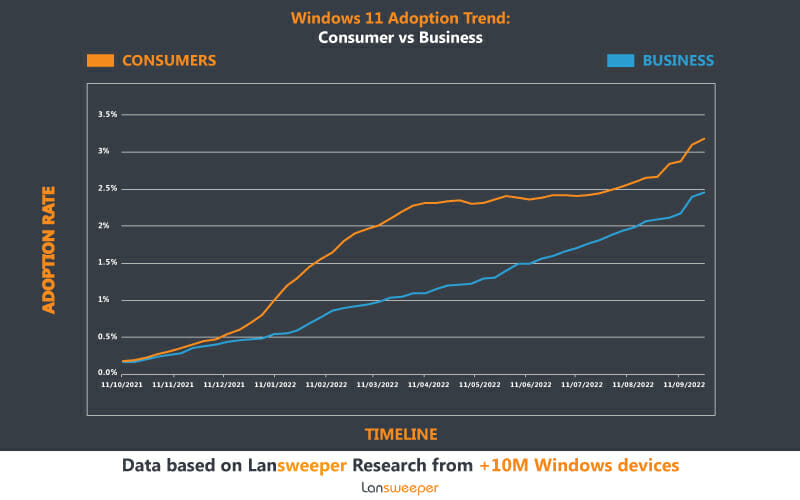A study by Lansweeper reveals that despite Microsoft’s best efforts to accommodate Windows 11 and its integration, nearly half of all systems are unable to download the new OS.
We’ve written about this previously in the journal, but to reiterate, there’s always been a notable gap between the introduction of a new Microsoft OS and its worldwide usage. Windows 10 and 7, despite being some of the best that the tech giant has produced, suffered with such pacing as well. This probably stems from a mixture of the user’s unwillingness to adapt, along with setups not being competent enough to support a new software build.
The former is probably more compelling of a reason than the latter in such cases; updating one’s OS to a new version is often such a hassle that people altogether avoid going for it as long as they can. However, Windows 7 and 10 still managed to catch on with a big chunk of the Microsoft consumer base within a year or so. With Windows 11 having very recently made its one-year birthday, as it was launched on the 5th of October, 2021, it’s time that we look at just how well the OS is performing in the marketplace. The answer is that progress and pacing could use some work.
Lansweeper is a cyber-ware firm that helps clients (usually in the form of major businesses) manage all IT-related options and outlets. It recently conducted a survey involving over 60,000 organizations and over 30 million individual Windows-supporting devices, all to establish just how feasible a Windows 11 installation even is. Designing a new OS is tricky stuff; while it needs to be top of the line and feature enough new content to justify its existence, adding too much will make the update impossible for older devices. It’s a difficult balance to strike, and Windows 11 has not done all too well in such regard.
The survey reveals that less than 50% of all current CPUs are unable to support Windows 11; while 91.05% of devices have enough RAM to support the new feature, only 52.55% of all devices have powerful enough TPMs installed to run the new OS. All in all, there’s a massive dearth of devices that can even withstand 11, so we’re going to be looking at lower download numbers moving onwards.
Windows 11 only has 2.5% of the OS marketplace, which is abysmal compared to Windows 10’s 81.87%. Even Windows 7, which has been completely unsupported for nearly a year by now, has a share of 3.38%, which bodes poorly for 11’s progress.
Read next: Survey Shows, How US Consumers Spend Their Bitcoins
We’ve written about this previously in the journal, but to reiterate, there’s always been a notable gap between the introduction of a new Microsoft OS and its worldwide usage. Windows 10 and 7, despite being some of the best that the tech giant has produced, suffered with such pacing as well. This probably stems from a mixture of the user’s unwillingness to adapt, along with setups not being competent enough to support a new software build.
The former is probably more compelling of a reason than the latter in such cases; updating one’s OS to a new version is often such a hassle that people altogether avoid going for it as long as they can. However, Windows 7 and 10 still managed to catch on with a big chunk of the Microsoft consumer base within a year or so. With Windows 11 having very recently made its one-year birthday, as it was launched on the 5th of October, 2021, it’s time that we look at just how well the OS is performing in the marketplace. The answer is that progress and pacing could use some work.
Lansweeper is a cyber-ware firm that helps clients (usually in the form of major businesses) manage all IT-related options and outlets. It recently conducted a survey involving over 60,000 organizations and over 30 million individual Windows-supporting devices, all to establish just how feasible a Windows 11 installation even is. Designing a new OS is tricky stuff; while it needs to be top of the line and feature enough new content to justify its existence, adding too much will make the update impossible for older devices. It’s a difficult balance to strike, and Windows 11 has not done all too well in such regard.
The survey reveals that less than 50% of all current CPUs are unable to support Windows 11; while 91.05% of devices have enough RAM to support the new feature, only 52.55% of all devices have powerful enough TPMs installed to run the new OS. All in all, there’s a massive dearth of devices that can even withstand 11, so we’re going to be looking at lower download numbers moving onwards.
Windows 11 only has 2.5% of the OS marketplace, which is abysmal compared to Windows 10’s 81.87%. Even Windows 7, which has been completely unsupported for nearly a year by now, has a share of 3.38%, which bodes poorly for 11’s progress.
Read next: Survey Shows, How US Consumers Spend Their Bitcoins




